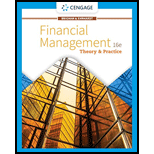
Concept explainers
1)
Case summary:
Employer of person X is considering an expansion into a similar filed which includes acquisition of Company T. He is also considering purchasing Company BM each with 5 million shares of stock.
The company has
To determine: The formula used to value the dividend paying stock irrespective of its dividend pattern.
2)
To determine: The constant growth stock and the way it is valued.
3)
To discuss: The effects when a company has a constant growth rate which exist its rs.constant growth stock and the way it is valued and whether the stocks have expected growth more than the required
Want to see the full answer?
Check out a sample textbook solution
Chapter 7 Solutions
Financial Management: Theory & Practice
- Muskoka Tourism has announced a rights offer to raise $30 million for a new magazine, titled ‘Discover Muskoka’. The magazine will review potential articles after the author pays a nonrefundable reviewing fee of $5,000 per page. The stock currently sells for $52 per share and there are 3.9 million shares outstanding. Required What is the maximum possible subscription price? What is the minimum? If the subscription price is set at $46 per share, how many shares must be sold? How many rights will it take to buy one share? What is the ex-rights price? What is the value of a right?arrow_forwardNorthern Escapes Inc. has 225,000 shares of stock outstanding. Each share is worth $73, so the company’s market value of equity is $16,425,000. Suppose the firm issues 30,000 new shares at the following prices: $73, $69, and $60. What will the effect be of each of these alternative offering prices on the existing price per share?arrow_forwardNeed answer correctly.arrow_forward
- Muskoka Tourism has announced a rights offer to raise $30 million for a new magazine, titled ‘Discover Muskoka’. The magazine will review potential articles after the author pays a nonrefundable reviewing fee of $5,000 per page. The stock currently sells for $52 per share and there are 3.9 million shares outstanding.arrow_forwardSs stores probarrow_forwardHenrietta’s Pine Bakery Corporation would like to raise $75 million to finance its expansion into new markets. The company will sell new shares of equity via a general cash offering to raise the needed funds. If the offer price is $15 per share and the company’s underwriters charge a 6% spread, how many shares need to be sold?arrow_forward
 Intermediate Financial Management (MindTap Course...FinanceISBN:9781337395083Author:Eugene F. Brigham, Phillip R. DavesPublisher:Cengage Learning
Intermediate Financial Management (MindTap Course...FinanceISBN:9781337395083Author:Eugene F. Brigham, Phillip R. DavesPublisher:Cengage Learning


